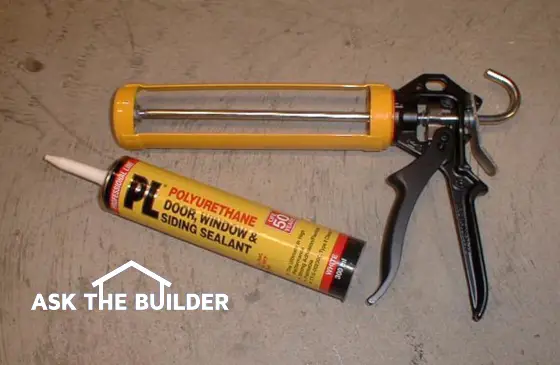Cracks Need Urethane Caulk

You are looking at a professional caulk gun and a tube of superb urethane caulk. Urethane caulk is sticky, but once it cures it is as pliable as an Olympic gymnast.
DEAR TIM: I have some difficult caulking jobs around my house. One happens to be some wood wainscoting in my kitchen. Each winter cracks appear between the pieces. I also need to caulk numerous exterior cracks adjacent to brick, wood and aluminum. Are there any high quality caulks that can withstand lots of movement? While I have your ear, just how do you create really smooth caulk joints? Sarah G., Bloomington, IN
DEAR NANCY: Ouch! I'll tell you how to get those smooth joints if you would just let go. Seriously, you have entered the caulk market at a superb time. There are some new caulks that have been introduced to the residential marketplace that will work well for all of your jobs.
The caulk industry has seen ever increasing improvements in many of its products. Traditionally there have been two major groups of caulks: solvent based and water based. New federal anti- pollution regulations regarding the release of volatile organic compounds (VOC) found in solvent based caulks have caused the caulk manufacturers to shift their attention and improve the water based products. Water based caulks now have better flexibility and better adhesion on smooth surfaces. Many residential caulks are made that meet or exceed commercial caulking specifications.
Probably the most exciting new residential caulk is urethane based. The product has been around for nearly 50 years but until recently, it was used primarily by commercial contractors. If you like silicone caulk, you are going to love urethane caulk.
Urethane caulks cure chemically just like silicone. They exhibit very low shrinkage, have a high tear resistance, are paintable and have excellent water resistance. Silicone caulk users know that paint and silicone simply don't mix. Once you let a urethane caulk cure, you can paint over it with no problems.
The urethane caulks stick very well to just about any surface. Urethane caulks will fill cracks next to vinyl siding, cedar (or any other wood), aluminum, and any masonry material. The urethane caulks adhere well because of a cross-linking chemical reaction. As the caulk cures, it actually interlocks with the material it is applied to. Water vapor fuels the chemical reaction. Beware, urethane caulks don't discriminate. If you leave some excess on your moist skin, the caulk will stick to you too!
One minor drawback of urethane caulks is their cure time. If you intend to paint a urethane caulk, you need to let it dry for at least 2 - 3 days before coating it with a water based paint. A 7 - 10 day drying period is necessary for oil based paints.
Keep in mind that caulks are a maintenance item. Even those that are advertised with extended warranties (20, 30 or more years) can fail. You need to periodically check exterior caulked seams to see if they are still in good shape.
The art of caulking is fairly simple. Most people are handicapped from the start because of an inferior caulk gun. Inexpensive caulk guns found in most paint stores and home centers have a low pumping ratio action. This means that lots of caulk is released with each squeeze of the gun. Professional caulk guns release far less caulk with each full trigger stroke. This enables you to more easily control the flow of caulk from the gun.
The tip of the caulk tube should be cut slightly smaller than the size of the crack being filled. Apply the caulk so a slight amount of excess mounds up over the crack. Gently slide your finger over the fresh caulk. If excess caulk begins to overflow around your finger you need to wipe this excess caulk into a rag. Water based caulk joints can be touched up with a damp rag or tile grout sponge for that professional look.
Related Articles: Urethane Caulk Benefits, Urethane Caulk Companies
Column 257